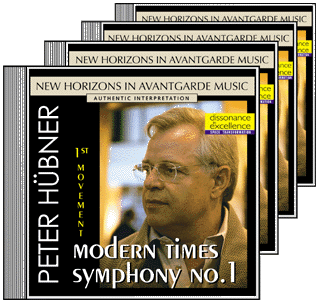
Peter
Hübner
Modern Times Symphony
1st - 4th Movement
Archaic
Soloists
Great Philharmonic Orchestra
Great Percussion Orchestra
Archaic
& Elektronic
Instruments
label: Dissonance in Excellence
total playing time: 3h 43’53”
For
more Information and if you want
to listen please visit:
![]()
Each tone fundamentally consists
of many, theoretically of a boundless number of tones. The unpractised listener
thinks that he only hears one tone, and the practised listener can hear
more tones – meaning a kind of sound. In our electronic age, with the
help of special technical equipment, quite a number of tones can be filtered
out of this so-called one tone, and amplified – so they really exist
and are not just imaginary.
These tones in a tone are usually called overtones. And all these tones
relate to each other in certain mathematical ratios. As a rule, one assumes
that the ratios are made up of whole numbers, i.e. 1:2:3:4:5:6 etc.. From
these ratios then follow the intervals, i.e. the distance of the tones to
each other, and the numbers the frequency and/or pitch proportions.
The first to investigate these ratios in the microcosm of music in our cultural
area, was the great physician, musicologist and mathematician Pythagoras
2500 ago.
The first impression that is given with the insight into the microcosm of
music, is that one tone consists of many tones, that, in reality, it is
a chord where the distance of the tones – taking the fundamental tone
as a starting-point – becomes closer and closer, and that, in general,
starting from the fundamental tone, they become quieter and quieter, until
you no longer hear anything.
So, if i.e., you play a tone on the piano, then, in reality, you hear many
tones on this side, and these tones swinging in one after the other, and
their volume proportions give us the impression of tone colour.
If, i.e., with the help of
electronic equipment, I stretch the process of the piano swinging in, we
get the impression that it is a different instrument – for instance,
a woodwind instrument or, with further stretching, a string instrument or,
with even further stretching, a brass instrument.
As already said, these are sort of the initial inaccurate impressions which
we gain with the insight into the microcosm of music. Upon closer examination,
we also come across a diversity of modulations between the different tones
of the microcosm of music and, of course, processes of swinging out.
In a way, it is like with the atom – where, first of all. we think
we are dealing with a particle, and upon closer examination find out that
these “particles” are composed of further particles, and that
these “particles” are again composed of different particles etc.
etc.. In the end, one doesn’t speak so much of particles any longer,
but of spatial and temporal structures, and then of spatial time structures
etc., etc..
When you have reached these levels of observation in the microcosm of music,
then you realise that the initial insight into this sounding field of creation
– with that fundamental tone and the overtones – were still very
inaccurate after all, well – almost deceptions.
Today’s official insight into the microcosm of music, as it exists
at music academies, is extremely limited, and in physics, for example, might
be compared to the mechanical age.
Therefore, it is only understandable that official experts show no special
interest in the microcosm of music, as this can only develop from a profound
insight into this harmonical field of creation. In comparison, official
experts would have to advance into the field of nuclear physics – not
to mention the sub-nuclear fields.
Well, that was a short digression into the possibilities which the music
experts are provided with, but with a little more insight into the microcosm
of music one can indeed realise that the outlying areas of the microcosm
of music, i.e. the tonal areas which are further away from the fundamental
tone present themselves subjectively to us more and more as dissonances,
whilst we feel that everything close to the fundamental tone is a consonance
or harmonious.
But the subjective feeling of perception of dissonance or consonance depends
on quite a number of other factors. It would take too long to explain them
at this point.
The existence of dissonance makes perfect sense, because it increases the
listener’s alertness.